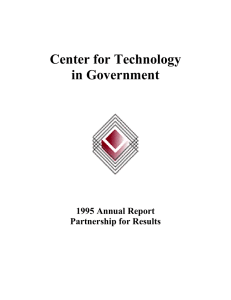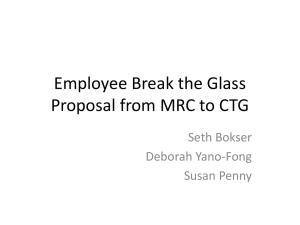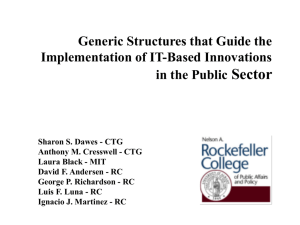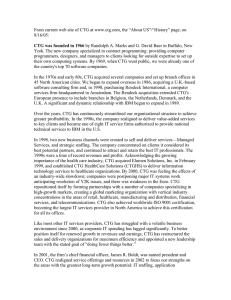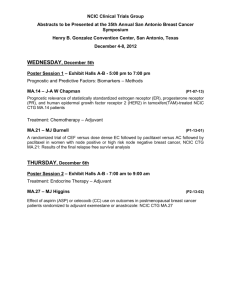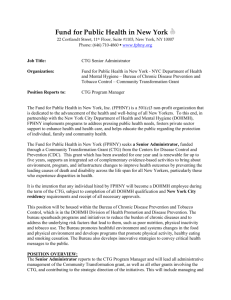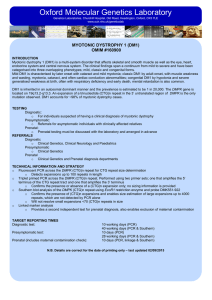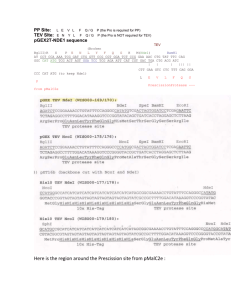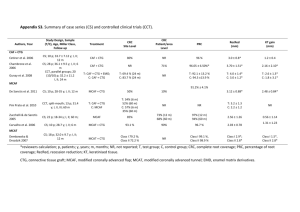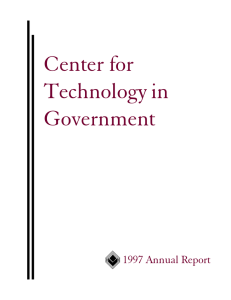1994 Annual Report July 1993 – June 1994 University at Albany
advertisement
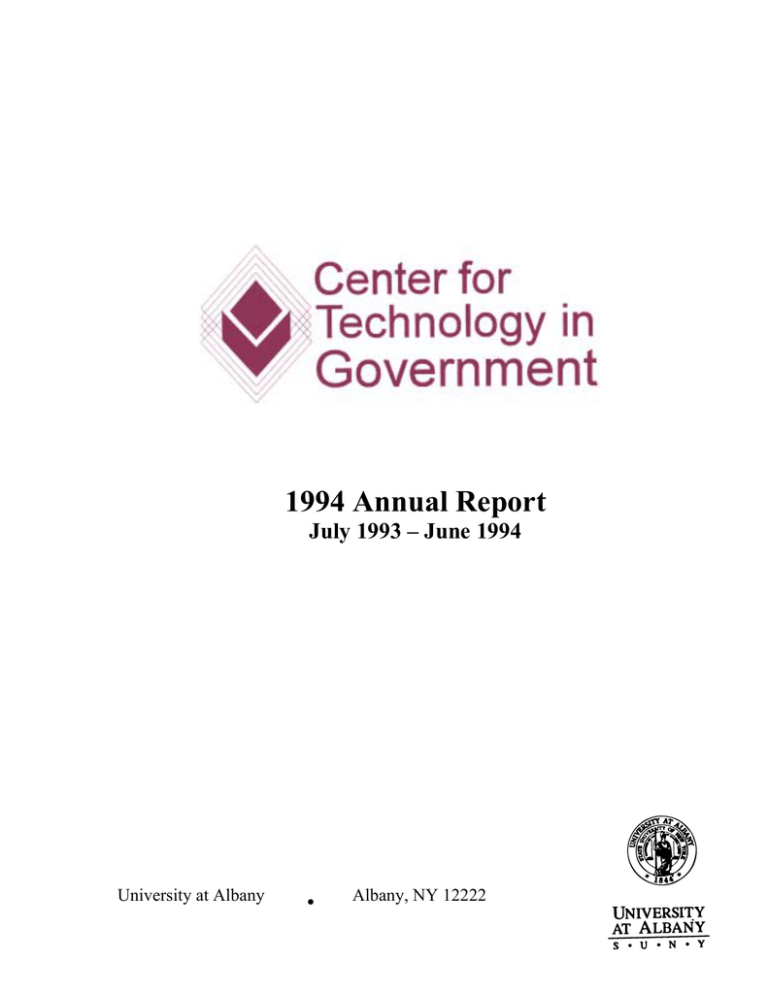
1994 Annual Report July 1993 – June 1994 University at Albany • Albany, NY 12222 “... we will set up a Center for Technology in Government to pursue new ways of applying technologies directly to the practical problems of information management and service delivery in the public sector— focusing on increasing productivity, reducing costs, increasing coordination, and enhancing the quality of government operations and public services.” Governor Mario M. Cuomo, 1993 State of the State Address The New York State Center for Technology in Government was created by Governor Cuomo and the Legislature and established on the University at Albany campus in July 1993. It conducts a government wide research and demonstration program devoted to the application of information technology to critical public problems. The Center seeks to reduce the costs and improve the quality of government services, reduce the risks of innovation, and share the results of its projects throughout the public sector. 2 The Center supports competitively selected projects through partnerships among government agencies, corporate contributors, and university faculty and students. During 1993-94, nearly thirty government agencies were involved in the Center's program through service on project teams, advisory committees, and peer review panels. Faculty and students from six academic units of the University (the Information Science Doctoral Program, Computer Science, Public Administration and Policy, Political Science, Educational Administration, and the School of Business) worked actively on applied research questions. In its first year of operation, CTG transformed an unused television studio into a state-of-the-art computing and communications laboratory, and attracted the support of nearly two dozen corporate partners who contributed hardware, software, technical support, and consulting services valued at more than $683,416. The Center staff, with assistance from the New York State Forum for Information Resource Management, evaluated nearly forty project proposals. Four of those proposals were selected by the Center's Advisory Board to become CTG projects. These flagship projects are assisting the Adirondack Park Agency, and the Offices of Mental Health, Mental Retardation and Developmental Disabilities, and Regulatory and Management Assistance to address mission-critical information management and service delivery problems. The Center also launched a technology testbed program whose first topic was software designed to enhance the performance of work groups. The year was capped by two national awards honoring the Center as the leading information technology management initiative in the fifty states and naming the Adirondack Park Agency project one of ten national prototypes which embody the principles of the National Performance Review. 3 ny citizen or business with a plan to develop real property in New York’s six million acre Adirondack Park needs information or a permit from the Adirondack Park Agency (APA). APA's decisions are based on a body of records which includes thousands of current and historic permits, legal documents, and maps kept in several physical formats. Consequently, those seeking assistance wait weeks or months for decisions, advice, or permits before they can proceed with development projects. APA's project at the Center involves a rapid document and map retrieval system for records related to real property. It combines digital imaging, database, geographic information system, and work flow technologies to create an immediately accessible "electronic file cabinet." Corporate partners as of June 1994 include Computer Sciences Corporation, Hewlett-Packard, and NYNEX. Several other companies including Environmental Services Research Incorporated and Oracle Corporation are slated to join the project as well. The academic research team includes faculty and students from information science, computer science and public administration. Immediate access to comprehensive electronic information will lead to far more rapid response to both governmental and public inquiries. The project will also generate information about integrated records management which has wide applicability throughout the government. Adirondack Park Agency: Balancing Environmental Quality and Economic Vitality A 4 ach year, thousands of small Office of Regulatory business entrepreneurs contact the Office of Regulatory and and Management Management Assistance (ORMA) for Assistance: Helping help and information about the wide array of permits required to establish Small Businesses or maintain a business within New York State. Callers often encounter busy signals and must wait to speak to a staff member in order to receive the information they need. ORMA's project at CTC is creating a prototype voice recognition/response system to allow callers direct access to the information they need, at the caller's convenience, 24 hours a day. The new system will enable callers to define their own permit assistance kits and to automatically receive the information they need by fax or mail. It will also allow callers to leave voice messages for staff and help them contact other agencies for special assistance. The project is supported by Precision Systems, Inc., Sun Microsystems as well as by a public administration research team. Prototype results will help ORMA redesign its permit assistance program to handle more business requests, provide more timely and comprehensive information, significantly improve customer service, and reduce labor costs. It will also produce information about the effectiveness of voice technology for direct customer interaction that will be of use to many other agencies. E 5 ver 100,000 people receive emergency psychiatric services in New York State each year, yet research shows substantial variability among emergency rooms regarding who is referred for psychiatric assessment and who is admitted to inpatient care or released to the community. Inappropriate decisions can have grave consequences for patients, their families, and their communities. The Office of Mental Health is working with CTG to develop a prototype decision model to assist general hospital emergency room personnel in making more consistent and accurate decisions about admission to inpatient care. Decision models reflect the consensus of experts about how information should be collected and how it should be used. They provide a means of putting the experience and training of the best professionals to use in improving the performance of all practitioners. Working with the University's Center for Policy Studies and a panel of expert clinicians, the Center is developing software for a field test in several hospital emergency rooms late in 1994. The model is designed to help avoid inappropriate admissions and discharges, reduce errors, and improve the use of hospital resources, leading to more appropriate care and better outcomes for patients. In addition, it will provide information about the use of technology in crisis decision situations that will be useful to many other organizations. Office of Mental Health: Making Psychiatric Assessments in Emergency Rooms O 6 ver the past decade, the Office of Mental Retardation and Office of Mental Retardation Developmental Disabilities (OMRDD) dramatically shifted its and Developmental program philosophy from one Disabilities: Supporting centered on state-operated institutional care to one centered on Community-based Services consumer-driven community-based services. This change was accomplished in large part by strengthening and expanding OMRDD's partnership with the voluntary sector. The agency's information systems now need to be redefined so that voluntary sector service data is fully available for program management needs. OMRDD's project recognizes that an information network for non-profit service providers must accommodate the wide diversity of organizations in the service network and their many levels of technical sophistication. An executive committee representing both OMRDD and nonprofit agency executives has defined the project scope to include recording, transmission, and use of service delivery information and the use of service records to support voucher and payment processing. The project evaluation is being conducted by researchers from educational administration and information science. The prototyping effort includes the investigation of several kinds of technologies including networks and magnetic cards. Information about technology tools to improve client choice, reduce administrative reporting, increase third-party revenue, achieve cost containment, and improve information sharing are all expected benefits of this project. O 7 Each CTG project is a partnership to re-engineer government through technology. A competitive selection process solicits mission-critical problems and the resulting projects involve the use of leading-edge technologies to help solve them. CTG provides state-of-the art computing and communications technology in its Government Technology Solutions Laboratory where project agencies have access to the products and services of CTG corporate partners. Each project is supported by a professional project manager and by university faculty and graduate students. Working in the Center, government agencies CTG Partners • assess the policy, management, and technical dimensions of a problem • work with academic and business partners to apply technologies as tools for problem solving; • build, test and evaluate prototype solutions, • and create new ways to use and share information— University Government Business all before making potentially extensive and costly capital and human resource investments in full scale systems. The combination of public, private, and university resources leverages the State's direct investment in CTG. The Center's first year appropriation of $1 million was significantly expanded by in-kind contributions from agency and corporate partners. By June 1994, CTG had spent about $600,000, the University at Albany had contributed start-up support worth about $123,000, agencies had committed more than $518,000 in in-kind effort, and corporate sponsors had contributed approximately $683,416 in products and services. 8 Value of In-kind Corporate Contributions July 1993 - June 1994 Corporate Partner Total Hardware $3,832 Anixter $8,335 Borland Computer Science Corp. $52,500 Digital Equipment Corp. $75,500 $215,258 Hewlett-Packard $29,000 IBM $1,550 Kirby Marketing $7,035 Lotus Microsoft Corporation $29,190 $51,126 Novell $839 NYNEX $450 Panduit Precision Systems, Inc. $99,666 $15,000 Sun Microsystems $56,725 SynOpdcs WordPerfect $21,355 $16,055 Xerox Corporation TOTAL Software Consulting $2,532 $72,000 $165,258 $29,000 $1,550 $839 $450 $8,335 $1,500 $40,000 $1,300 $52,500 $2,000 $10,000 $7,035 $29,190 $51,126 $94,666 $5,000 $15,000 $10,055 $683,416 $296,684 $8,490 $4,355 $2,000 $246,697 $48,235 $17,000 $4,000 $140,035 The Center's early success would not have been possible without the confidence and contributions of two agencies and several corporations which sponsored informal projects in 1992-93. These early efforts were instrumental in demonstrating the value of a formal, government-supported R&D organization for New York State. The Department of Motor Vehicles Title Imaging Project was supported by AT&T Global Information Solutions, New Vision Systems, Grumman Data Systems, DRT Systems, OA Systems, and GTE/Vantage. A full-text retrieval project involving the State University of New York Central Administration was supported by Bell Communications Research and Digital Equipment Corporation. Both projects allowed university, agency, and corporate participants to understand the value of partnerships across sectors and to build a solid foundation of policies, practices, and relationships which supported the rapid development of CTG during 1993-94. 9 The Center provides agencies the opportunity to experiment and learn about what works and what does not work, in low-cost, low-risk pilot projects before high-stakes, high-cost systems are developed or purchased. The development of prototypes gives agencies first-hand knowledge of how technology can improve their services, bow it can be integrated with existing systems, and how it can solve their operations and service delivery problems. he Solutions Laboratory is a network-based infrastructure which provides he technical platform for most CTG projects. By June 1994, the lab housed several local area networks and servers, as well as a variety of workstations and peripheral devices including printers, scanners, and plotters. Powerful software development tools as well as off-the-shelf software packages are installed and available for use by project teams. Wide area communications lines are available as well as access to CAPNET, EmpireNet and the Internet. The Lab serves as the common development site for project prototypes and is used often to present demonstrations of work-in-progress. The Government Technology Solutions Laboratory 10 T echnology Testbeds begin with the selection of an emerging technology for which there is little hands on experience within New York's public sector. The neutral environment of the Solutions Lab allows agencies to focus entirely on acquiring knowledge and experience with specific technologies that are not available to them in their own agencies. The Center's first testbed, on "groupware," investigated several products which support the interactions of individuals working in teams or groups. The Groupware Testbed was supported by Lotus Development Corporation and WordPerfect Corporation. It also included a meeting support software package, Decision Web, developed jointly by researchers at the University of Budapest and the University at Albany. Agency participants included the Office of the State Comptroller which used WordPerfect Informs to prototype an executive correspondence control system, the NYS Forum which joined CTG staff in testing Lotus Notes for joint project tracking and report writing, and the Center's own Research Team which tested the brainstorming and categorizing features of Decision Web. T Technology Testbed Projects 11 The CTG model does not limit itself to technology alone. Projects are structured to give full attention to related management and policy issues and the prototypes are designed and evaluated with the needs and limitations of real organizations in mind. A particularly valuable element of each project is the ability to demonstrate the prototype to the people who will actually work with any new system and to involve them directly in helping to CTG Project Focus redesign their own jobs, processes, and support systems. Each project includes a literature review and a survey of current practices which document Policy how others are approaching the same topics. Baseline performance data is collected and compared with prototype performance in order to help agencies evaluate their choices and make decisions about eventual implementation. CTG fully documents project results in formal reports Management Technology and sponsors information dissemination, management education, and technology transfer programs as ways to leverage the benefits of any single project. Reports are distributed in print and available over the Internet. This year the Center was honored with two national awards. In May 1994 it was named the top information policy and management initiative in the fifty states by the National Association of State Information Resource Executives. In June, the Adirondack Park Agency project was selected by Interchange '94 as one of ten national prototypes to represent the principles of Vice President Gore's National Performance Review. The project prototype will be demonstrated and highlighted in discussions at a national conference in October. CTG has also been cited in Governing, American City and County Magazine, State Information Policy News, and other national publications. 12 Rudy Runko Director Division of the Budget Diana Ritter Executive Deputy Director, Office of Public Health Department of Health Ruth Walters Special Assistant to the Governor Office for Regulatory and Management Assistance Ronald Cooke, Chair, Office of Mental Retardation & Developmental Disabilities Charles Blunt, State University of New York Edward DeFranco, Office of Alcoholism and Substance Abuse Services Jacqueline Del Rossi, Workers'Compensation Board Thomas Donovan, Department of Environmental Conservation Paul Fisk, Division of Budget Howard Geer, Division of Equalization and Assessment Peter Poleto, Department of Motor Vehicles Douglas Williams, Office of the State Comptroller Martin Zakis, Office of Regulatory and Management Assistance ~ Center for Technology in Government University at Albany - SUNY Albany, NIY 12222 info@ctg.albany.edu (518) 442-3892 UNIVERSITY AT ALBANY S U N Y
